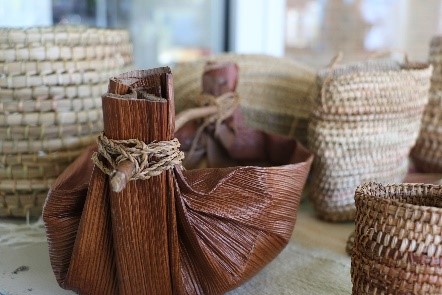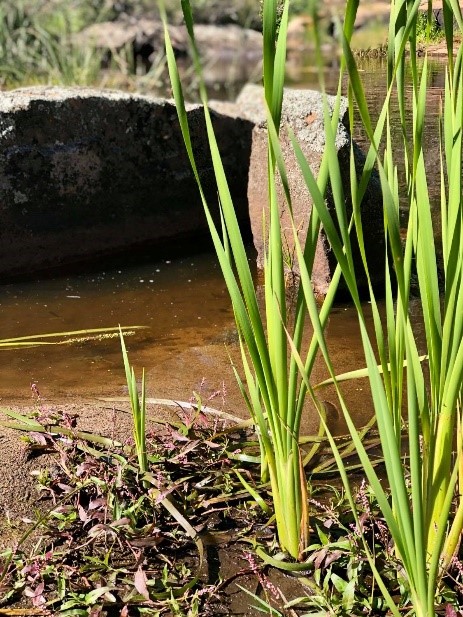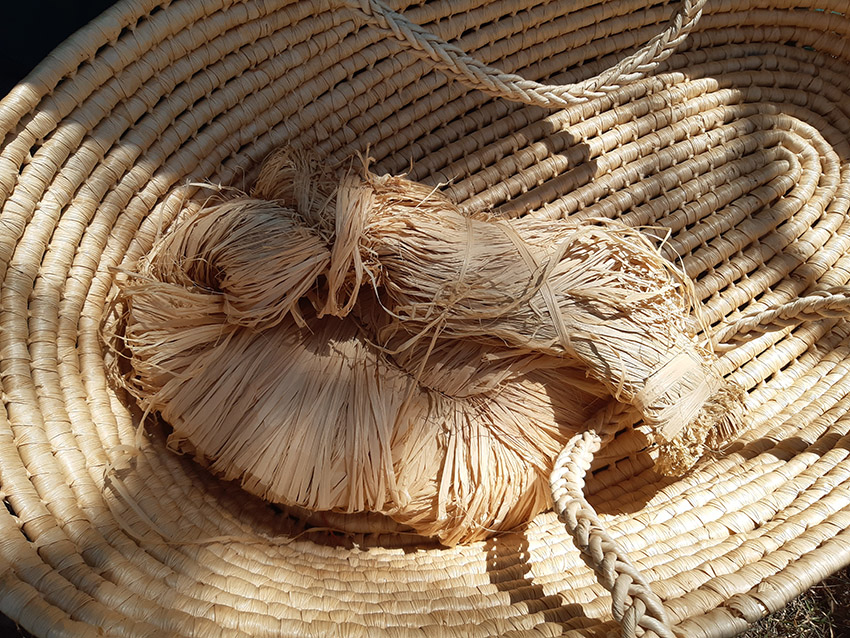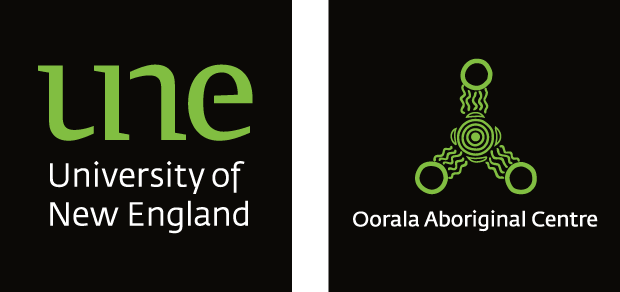Materials for woven artefacts
The materials used in weaving are collected from the natural environment. The materials used depend upon what is local. Although reeds and grasses from other environments and nations are now also used.
Bangalow Palm
The Bangalow Palm is native to the rainforests of the central eastern Australian Coast from Mackay to Batemans Bay. It is fast growing and robust. It has a single slender trunk, which grows to a height of 20 – 25 metres with feather-leaved fronds. The trunk is smooth and ringed with closely spaced leaf scars. It is brown to greenish grey turning pale grey when older.
Collecting Bangalow Palm is relatively easy because of its ‘self-cleaning’ habit, it drops its old leaves to the ground. The materials are ready for use after dampening/soaking to make the fibre more pliable. Materials from Bangalow palms can be used for folding, coiling, weaving, twining, and random weave.
Bangalow palm water carriers
Bangalow palm sheath becomes malleable one soaked for a period of time in water. The sheaths are then folded carefully, neatly rolling the sheath at the ends. A wood handle is inserted into the two ends and then bound with a fine piece of vine or stout grass.
Mary Bundock, writing in 1890s, observed that large water carriers such as these could contain ‘half a bucket of water’. They were quickly supplanted by European containers.
Buchie Rush/ Baumea Rubiginosa
Buchie Rush is long, apple green, round reed with a pointed tip, with a pink tinge to the base of the stem. It is a native fibre that is used to make coiled, looped and knotted bags. The reed grows in ephemeral swamps and along the margins of freshwater swamps in water 0 – 50 cms deep. It can be found in low nutrient sandy, peaty soils. It tends to grow shorter in dry ephemeral and taller when in permanent water.
The reeds slide out easily when it is ready to be picked. Traditionally the reed ‘were cleaned, soaked in water for a little time, subsequently dried and toughened over hot ashes. However due to restriction of fire, this practise may not be possible. Thereupon fibres are usually dried out for approximately three to four weeks and then rehydrated prior to weaving. To prepare reeds for weaving; wet the reeds and then wrap in a wet towel, allow 8 – 12 hours before using.
Lomandra Longifolia / Spiny-headed Mat-rush
A 1-2 m tall grass-like plant with strap-shaped leaves about 1cm in width. The spiky, white to pale tan, long, flower heads and seeds are highly scented. It grows in thick clumps.
The long smooth leaves of Lomandra are used to make baskets and mats. The long leaves are easily to strip.
It is best to strip the fibre immediately after picking. Once leaves are stripped, they are tied in bundles to dry out.
To prepare the rushes for weaving; wet the stripped leaves and then wrap in a wet towel, allow 8 – 12 hrs before using.
Raffia palms (Raphia)
Raffia palms are a genus of about twenty species of palms native to tropical regions of Africa, and especially Madagascar, with one species (R. taedigera) also occurring in Central and South America
The raffia fiber is soft, pliable, strong, durable, easy to dye and biodegradable making it an excellent material for weaving baskets, hats, mats and rugs.
It is also widely used for agricultural purposes to tie vegetables, plants in vineyards, flowers and floral arrangements.
Raffia is made from the ’segments’ of the leaves on the Palmyra palm, a tree native to Madagascar. Yep, on a palm tree, the ‘leaf’ is actually what many of us might look at and call a ‘whole branch’ – so the leaves on the raffia palm are typically 10 metres long or more, and the segments are dried and shredded ‘leafy bits’ becoming the raffia fibre we use. These vary in length depending on their position on the leaf. Segments range in length from 1-2 metres; with the shortest strands coming from the base and tip, and longest, best quality strands coming from the middle.
Adele and Avril share where they find lots of materials for weaving. Not all materials are from the natural environment. Some you will find is shops.
Topics in this lesson:



